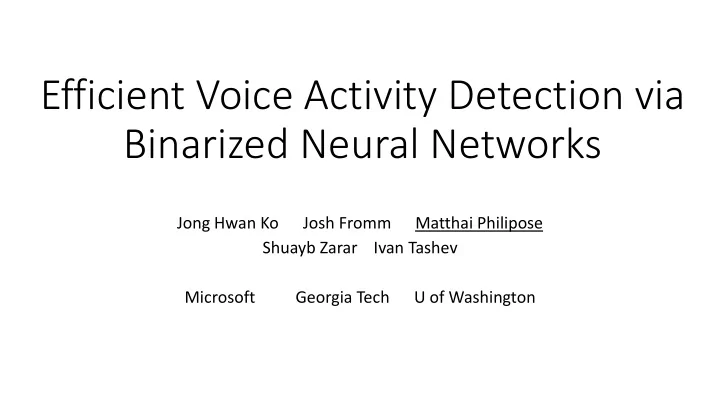

Efficient Voice Activity Detection via Binarized Neural Networks Jong Hwan Ko Josh Fromm Matthai Philipose Shuayb Zarar Ivan Tashev Microsoft Georgia Tech U of Washington
Voice Activity Detection (VAD) • Need to run on a fraction voice noise of a CPU • Traditionally (pre-2016) • Based on Gaussian Mixture Models • Google WebRTC state of the art: 0 0 1 1 1 1 1 0 1 1 1 0 0 1 1 1 0 1 1 1 1 0 • 20.5% error • 17 ms latency …
VAD with DNNs • Simple DNN on audio 0 1 1 0 0 1 1 0 … spectrogram † Current 1 0 0 0 1 0 0 0 … [noisy features, frame 1 1 1 0 1 1 1 0 … † I. Tashev and S. Mirsamadi, ITA 2016 ground-truth labels] 3 3 7-frame … … … … … … … … … window • Results: Input: 256x7 (1792) • ☺ 5.6% error (from 20.5%) 512 512 Hidden • 152ms (from 17ms) 512 Output: 257 0 1 1 0 0 1 1 0 … Predicted 1 0 0 0 1 0 0 0 … Labels 1 1 1 0 1 1 1 0 … … … … … … … … … … Idea: Quantize DNN to very low (1-3 bit) bitwidths
Implementing Binarized Arithmetic • Quantize floats to +/-1 1.2 3.12 -11.2 3.4 -2.12 - 132.1 … 0.2 - 121.1, … • 1.122 * -3.112 ==> 1 * -1 • Notice: 64 floats • 1 * 1 = 1 • 1 * -1 = -1 64 bits 0b110100…1 0x0… • -1 * 1 = -1 • -1*-1 = 1 A[:64] . W[:64] == popc(A /64 XNOR W /64 ) • Replacing -1 with 0, this is just XNOR • Retrain model to convergence
Cost/Benefit of Binarized Arithmetic float x[], y[], w[]; ... for i in 1…N: y[j] += x[i] * w[i]; 2N ops ~40x fewer ops 32x smaller unsigned long x[], y[], w[]; 3N/64 ops … for i in 1…N/64: y[j] += 64 – 2*popc(not(x_b[i] xor w_b[i])); Problem: Optimized model slower when measured!
Kang et al. ICASSP 2018 Try Again, With Custom GEMM Operation Per-frame error (WebRTC=20.46%) feature quantization bits Model N32 N8 N4 N2 N1 5.55 weight quantization bits W32 W8 6.25 6.45 7.23 13.87 Sweet spot: W4 6.16 6.47 7.32 14.11 ☺ ~5ms latency (30.2x faster) ☺ additional 2.4% accuracy loss 7.92 W2 6.63 7.06 13.88 W1 7.91 8.47 8.97 14.95 Takeaway: Compilers (a la TVM/Halide) essential for new ops.
Recommend
More recommend